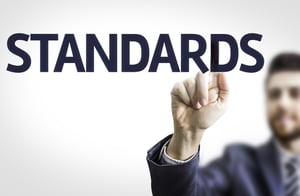How Your Organization Can Benefit from Standardization
Imagine if every day you had to relearn a process or use a different CMMS. Chances are you would get virtually nothing accomplished, leaving your plant operating poorly. Now we all know that we having to relearn a process every day or using a new CMMS is not practical nor is it rooted in reality (not to be confused with the Rooted in Reliability Podcast). But this type of thing happens more often than you may think.
When people change positions in an organization, the processes shouldn’t change but they do in most organizations. Why is that? There are no standards or standard processes in place. The same thing happens when organizations do not have data standards in place. The equipment or failure data is not captured in a structured way, which leads to the inability to run the meaningful analysis.
What are Standards?
According to the New Short Oxford English Dictionary, a standard is “a document specifying nationally or internationally agreed properties of manufactured goods, principles for the procedure, etc.”

In other words, a standard is a prescribed way of doing something, or what should be recorded in what format. By standardizing
processes and information, organizations can ensure that products and services are safe, reliable and of good quality.
From a business standpoint, they are strategic tools that reduce costs by minimizing waste and errors and increasing productivity. They achieve this by establishing repeatable ways in which processes are completed and to what level of quality. Having standards in place (from an organizational level) ensure that all sites are doing things the same way, and that way will not change when new people are put
Why Standards are Ignoredinto the role.
If standards are such great tools, why are they not used? There are many reasons, but a few of the most commonly heard ones will be discussed.
- “But I know how to do my job”. This may be true, but what happens when a person is out on vacation and others have to fill in? Or when a person moves on to a new role? This leaves the process open to change and just not for the good of the business
- “No one can tell me how to do my job”. The best person to write the first draft of the standard is the person who does it every day. They have developed their own internal standard based on years of experience. So use it.
- “I’m not going anywhere”. While the person’s current intention may not be to move on, or change positions, life does happen. Try explaining that this will help to manage the mess that occurs after they are off on vacation. They may appreciate the reduction in post-vacation
By overcoming some of the resistance to standards and standardization, you can begin your journey to sustainability.
Where Should You Start?
One major step to achieving the adoption of standards is to have the staff understand that standards are not just for them, but for the long-term sustainability of the business. Once they have the understanding of why standards are important, have them draft the standard(s) and ensure that you give them credit for it, but putting their name as the author.
So what standards should you start with? Start with documenting the major processes & performance requirements in your maintenance department;
- CMMS Usage (Who does what, when, how, etc.)
- Maintenance Planning & Scheduling Process (criteria for prioritization, job plan requirements, etc.)
- Storeroom Process (Stocking parts, criteria to evaluate parts, etc.)
- Root Cause Analysis Process (Triggers, Types of tools, etc.)
By documenting the key processes, the processes will be executed consistently, correctly and provide the ability to analyze and improve the process and its outputs. Without a standard way of doing things, the variability will be too much to overcome.
Standardization is a key step to sustainable improvements, not just in a site but across multiple sites within an organization. Imagine having a single instance of a CMMS with 30+ sites using it. But all sites use it differently (equipment & parts naming, closing out work orders, statutes, etc.). How can improvements be made to the system? They can’t.
Do you have your major processes documented? When was the last time they were updated? Will you make it a priority to start the standardization process? Please leave a comment and let us know where you are in your standardization journey and why.
Remember, to find success, you must first solve the problem, then achieve the implementation of the solution, and finally sustain winning results.







